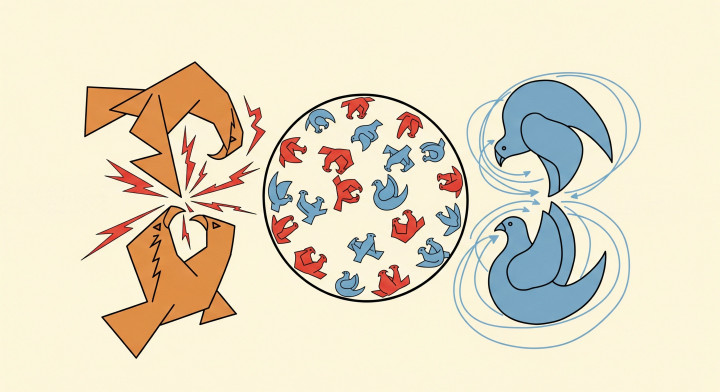Order in the Unpredictable
Why is it so difficult to predict the weather more than a week in advance? Why can a tiny change in a system lead to a dramatically different outcome? These are the kinds of questions that led to the development of one of modern science's most fascinating fields: chaos theory.

Far from being about pure randomness or disorder, chaos theory is the rigorous study of systems that are deterministic—governed by strict rules—yet produce behavior that is, for all practical purposes, unpredictable. It’s a field that uncovers a hidden, intricate order within what appears to be random noise.
What is Deterministic Chaos?
At its heart, chaos theory explores a seeming paradox. It focuses on systems whose evolution is described by precise, deterministic laws, meaning there is no element of chance involved. If you know the exact starting conditions, you can, in principle, calculate the system's entire future. However, in a chaotic system, this "in principle" becomes impossible "in practice." This phenomenon, where deterministic rules give rise to unpredictable and seemingly random behavior, is known as deterministic chaos. It's not the chaos of a messy room, but rather the complex, structured chaos of a turbulent waterfall or a flickering flame.
From Celestial Mechanics to Weather Forecasts
The seeds of chaos theory were sown long before the term was coined. In the late 19th century, the French mathematician Henri Poincaré was studying the "three-body problem"—the challenge of predicting the gravitational paths of three celestial bodies, like the Sun, Earth, and Moon. He discovered that even this simple Newtonian system could exhibit astonishingly complex and non-repeating orbits. He found that a minuscule change in a body's initial position or velocity could lead to a wildly different trajectory over time. This was a profound realization that chipped away at the "clockwork universe" model, suggesting that not all deterministic systems were neatly predictable.
The field took its next giant leap in the 1960s with the work of meteorologist Edward Lorenz. While running a computer model to simulate weather patterns, he decided to re-run a simulation from the middle. To save time, he manually entered the numbers from a previous printout, but he rounded them from six decimal places to three (e.g., from 0.506127 to 0.506). This seemingly insignificant tweak produced a completely different weather forecast. Lorenz realized that in his system, tiny, imperceptible differences in initial conditions could amplify exponentially, making long-term prediction impossible. This became famously known as the butterfly effect—the metaphorical idea that a butterfly flapping its wings in Brazil could set off a tornado in Texas.
The Core Concepts of Chaos
To describe these complex systems, scientists developed a new vocabulary and a set of powerful mathematical tools. Three concepts are central:
- Sensitive Dependence on Initial Conditions: This is the formal term for the butterfly effect. It means that any two starting points, no matter how close, will eventually diverge at an exponential rate. This is the hallmark of chaos. It places a fundamental limit on our ability to predict the future of such systems, creating a "prediction horizon" beyond which any forecast is no better than a guess.
- Strange Attractors: While a chaotic system’s path is unpredictable, it is not completely random. Its behavior is often confined to a specific, intricate shape within its "phase space" (a mathematical space representing all possible states of the system). This boundary is called a strange attractor. These attractors often have a fractal structure, meaning they exhibit self-similarity at all scales—if you zoom in on a piece of the attractor, you see a smaller version of the whole structure. The famous Lorenz attractor, which looks like a butterfly's wings, is the classic example, showing how the weather system he modeled was both unpredictable and bounded.
- Lyapunov Exponent: To quantify how chaotic a system is, mathematicians use the Lyapunov exponent. This value measures the average rate at which nearby trajectories in the phase space diverge. A positive Lyapunov exponent is a definitive sign of chaos. The larger the exponent, the faster the divergence and the shorter the prediction horizon.
Practical Applications
Chaos theory is far more than an abstract mathematical curiosity. Its principles are used to understand and model complex phenomena across many disciplines:
- Meteorology and Climate Science: As Lorenz discovered, chaos theory explains why long-range weather forecasting is inherently limited. However, it also helps create better short-term "ensemble forecasts," where meteorologists run a model many times with slightly different initial conditions to map out a range of possible outcomes.
- Biology and Ecology: It helps model population dynamics, explaining the "boom and bust" cycles of certain animal species. In medicine, analysis of heart rate variability has shown that a healthy heartbeat has a degree of chaotic irregularity, while a perfectly regular (or overly random) one can be a sign of disease.
- Engineering and Physics: Chaos theory is essential for understanding turbulent fluid flow, the behavior of lasers, the vibrations in mechanical structures, and the stability of electrical power grids.
- Economics and Social Sciences: Financial markets, with their wild and unpredictable fluctuations, are often analyzed using tools from chaos theory. It is also applied to model social dynamics, the spread of information, and even pandemic response strategies, helping to understand how small interventions can sometimes have large, non-linear effects.
A Legitimate and Thriving Science
It's crucial to understand that chaos theory is not a pop-science metaphor or a speculative philosophy. It is a rigorous, highly mathematical branch of science with a solid theoretical foundation in the study of dynamical systems. There are dozens of peer-reviewed journals, such as Chaos: An Interdisciplinary Journal of Nonlinear Science and Physical Review E, dedicated to its research. Its concepts, from Lyapunov exponents to Poincaré maps, are based on proven theorems and are verified through both computer simulations and physical experiments.
In conclusion, chaos theory is a genuine and powerful scientific framework. It provides us with the tools to understand systems that were once considered hopelessly complex or purely random. It has fundamentally changed our worldview, replacing the simple Newtonian clockwork with a universe that is far more intricate, dynamic, and interesting. It teaches us that even in systems governed by simple, deterministic rules, the world can be beautifully, structurally, and—in the best way possible—unpredictable.





